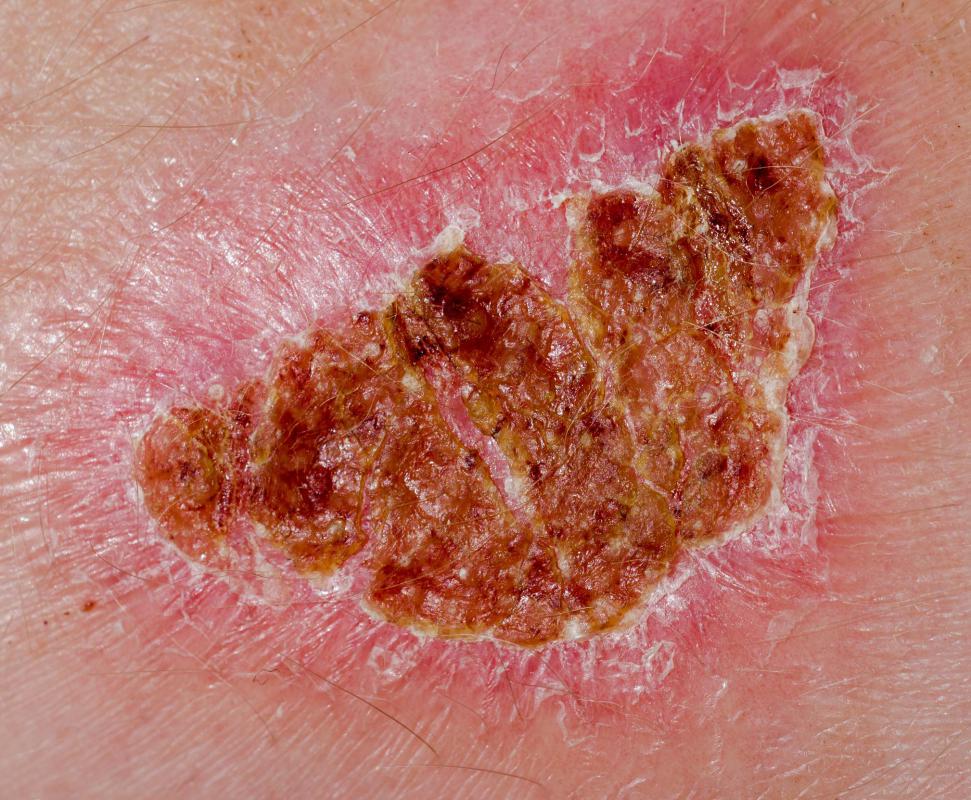At TheHealthBoard, we're committed to delivering accurate, trustworthy information. Our expert-authored content is rigorously fact-checked and sourced from credible authorities. Discover how we uphold the highest standards in providing you with reliable knowledge.
What is Wound Pathophysiology?
Wound pathophysiology refers to the processes that impair the normal healing of a wound, such as infection or certain types of scarring, and lead to complications such as a chronic wound. There are four categories of wounds considered in a medical assessment: clean, contaminated, clean-contaminated, and dirty. Each type of wound has a different risk of complications from pathophysiology.
Clean wounds have the lowest infection rate and the best prognosis for healing. Clean-contaminated wounds have minimal — less than 10% — risk of infection and are often intentionally inflicted in the course of small surgeries. Greater incidence of wound pathophysiology comes from contaminated wounds, which have higher bacterial presence, such as wounds from colon surgery or the removal of an inflamed appendix. The highest risk of complications comes from a dirty wound, which can result from a traumatic perforation, such as a stabbing, an open fracture, a burst appendix, or a bullet wound. Antibiotic treatment and sometimes debridement, which is the removal of tissue, are necessary to prevent the wound from becoming infected.

Normal wound healing begins with an inflammatory phase, with lots of redness and swelling. First, a cascade of molecular reactions leads to the clotting of blood cells to prevent further bleeding. Then various immune cells migrate to the site of the wound, starting with neutrophils, then macrophages and fibroblasts over a two-day period. These remove debris and bacteria, cleaning the wound.

Regrowth of skin over the wound, called epithelization, follows. Fibroblasts rebuild the tissue after the inflammatory phase, making collagen and increasing the strength of the damaged area. Soon, a new system of blood vessels is in place, while collagen becomes stronger by cross-linking. This is the period when the scar settles and can last from days to years, depending on the wound.

The most common wound pathophysiology is infection. At first, it appears identical with the inflammation of the wound, but it persists and impedes healing. Whether a wound becomes infected depends on a number of factors, especially the level of bacterial contamination, the extent to which the wound is cleaned, which microorganisms are present, and the use of antibiotics. Poor nutrition, old age, steroids in the bloodstream, diabetes, and obesity often cause complications to wound healing, particularly by increasing susceptibility to infection.
In addition, antibiotic-resistant bacteria found in hospitals present challenges to the healing of surgical wounds. An infected wound will not close properly and will remain sensitive or painful. Infections might result in chronic persistent wounds or, in severe cases, might result in gangrene or sepsis in the bloodstream.
Beyond infection, pathophysiology might involve scar tissue. Certain kinds of tissue, such as the eyes, can be permanently impaired by scarring and, consequently, even normal processes of inflammation and wound repair can leave function impaired. Even mild wounds can induce damaging pathological processes because of the delicacy of the tissues involved.
Some wounds do not repair properly, because of an overgrowth of collagen during the healing process. In serious cases, this can result in a keloid scar, which covers the area of the wound with painful, fibrous growths. A milder condition of excess scar tissue is found in hypertrophic scars, which involve a thick scar raised above the surrounding skin.
Chronic wounds are wounds that do not heal properly and persist for a long time or recur in the same injured tissue, sometimes for years. They include pressure sores, chronic hemorrhoids, diabetic sores, and ulcers in leg veins. In "normal" or acute wound healing, degradation of contaminated tissue is followed by a proportional amount of rebuilding in the wound with collagen. In chronic wounds, there is more degraded tissue than there is collagen to replace it. Further, they are accompanied by chronic pain.
Poor circulation, an impaired immune system, and malnutrition all contribute to chronic wounds. Chronic wounds such as bedsores remain unhealed because the pressure causing the injury persists without relief. In diabetics, however, there is the added factor of neuropathy — disease of the peripheral nerves, often in the feet. Sometimes, as in diabetes, chronic wound pathophysiology is part of a larger illness afflicting a patient. Diabetics suffer from both higher infection rates and slower replacement of tissue in acute wounds, and they are likelier to experience chronic wounds.
AS FEATURED ON:
AS FEATURED ON:













Discuss this Article
Post your comments